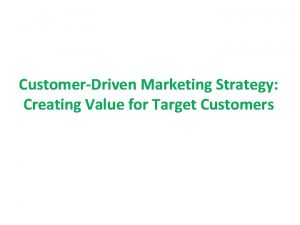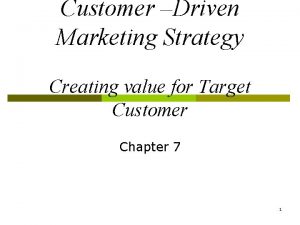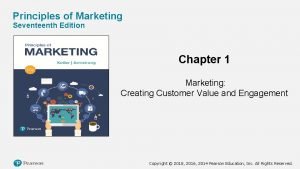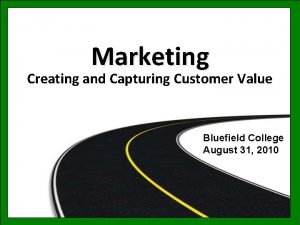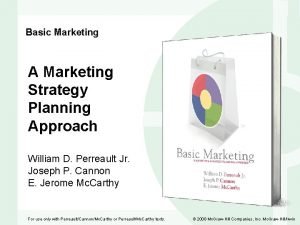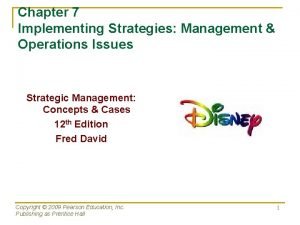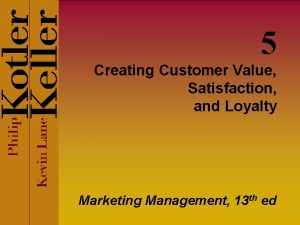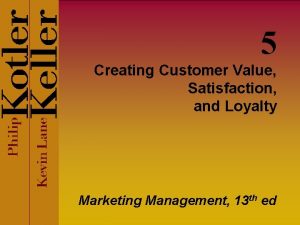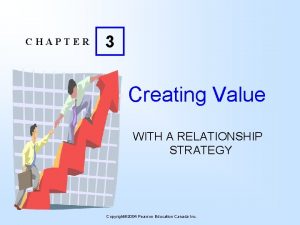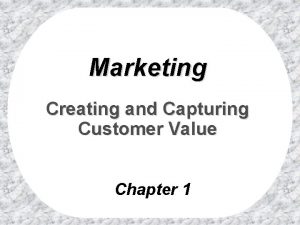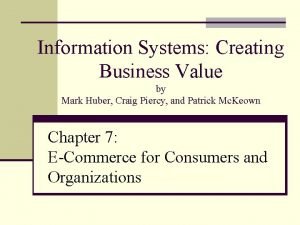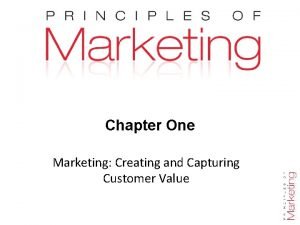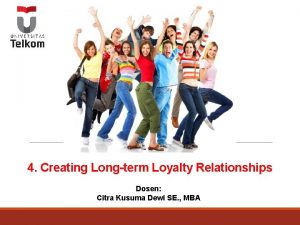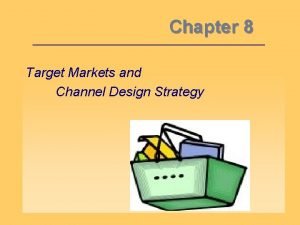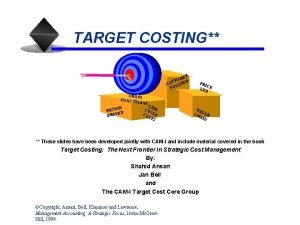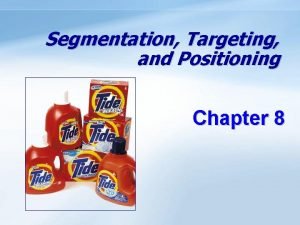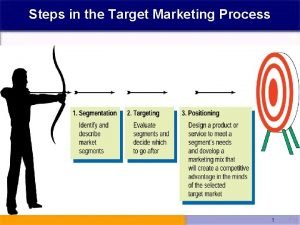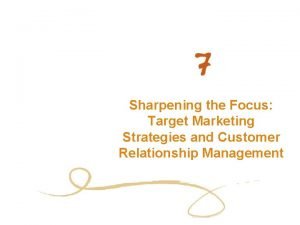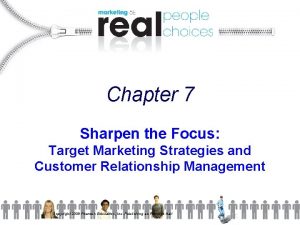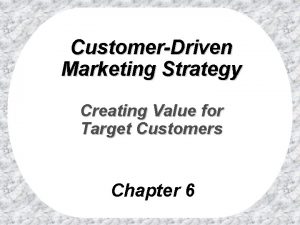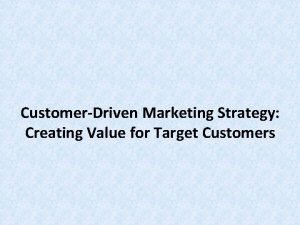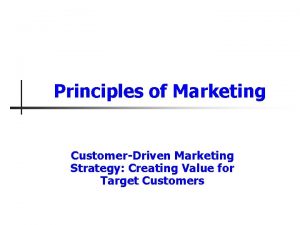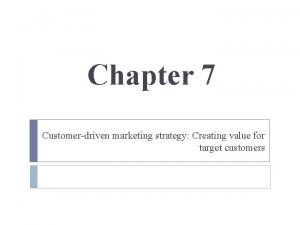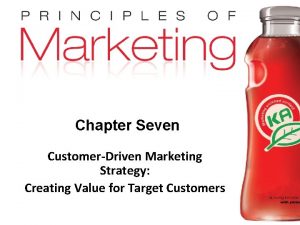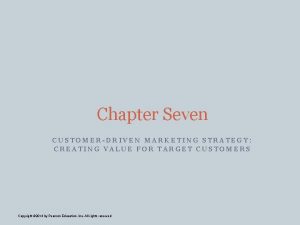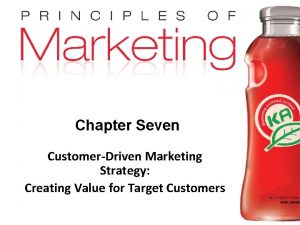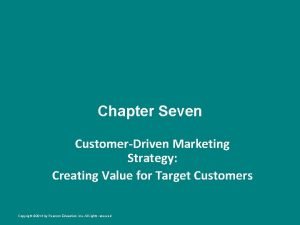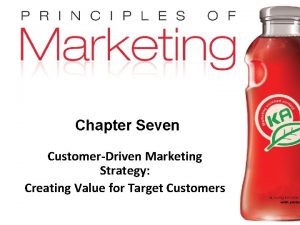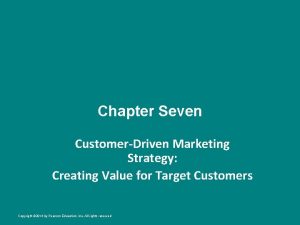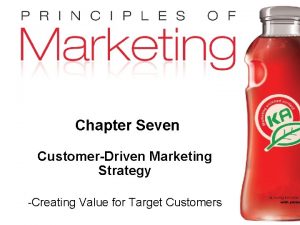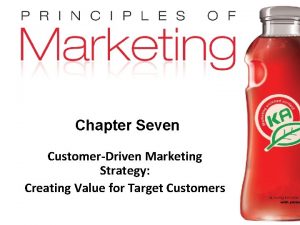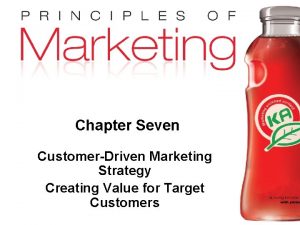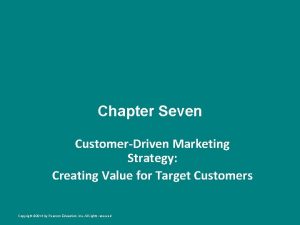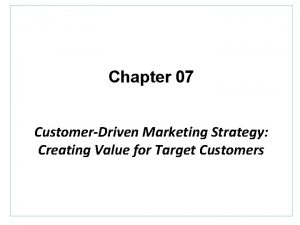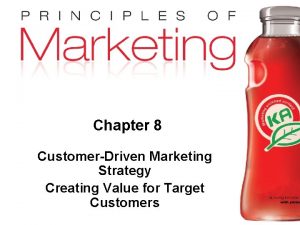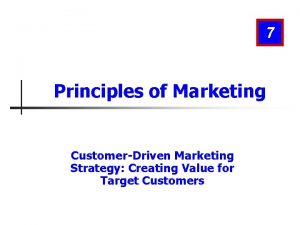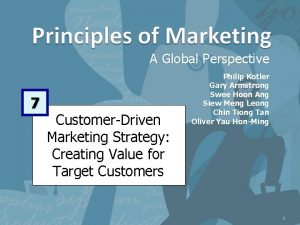Chapter07 CustomerDriven Marketing Strategy Creating Value for Target



































- Slides: 35

Chapter-07: Customer-Driven Marketing Strategy: Creating Value for Target Customers Market segmentation is the process that companies use to divide large heterogeneous markets into small markets that can be reached more efficiently and effectively with products and services that match their unique needs

Segmenting Consumer Markets • Geographic segmentation divides the market into different geographical units such as nations, regions, states, counties, or cities • Demographic segmentation divides the market into groups based on variables such as age, gender, family size, family life cycle, income, occupation, education, religion, race, generation, and nationality – Age and life-cycle stage segmentation is the process of offering different products or using different marketing approaches for different age and life-cycle groups – Gender segmentation divides the market based on sex (male or female) – Income segmentation divides the market into affluent or low-income consumers • Psychographic segmentation divides buyers into different groups based on social class, lifestyle, or personality traits

• Behavioral segmentation divides buyers into groups based on their knowledge, attitudes, uses, or responses to a product – Occasions – Benefits sought – User status – Usage rate – Loyalty status Using Multiple Segmentation Bases • Multiple segmentation is used to identify smaller, better-defined target groups • Geodemographic segmentation is an example of multivariable segmentation that divides groups into consumer lifestyle patterns

Segmenting Business Market Segmenting International markets • Intermarket segmentation divides consumers into groups with similar needs and buying behaviors even though they are located in different countries Requirements for Effective Segmentation • Measurable • Accessible • Substantial • Differentiable • Actionable Market Targeting • Evaluating Market Segments – Segment size and growth – Segment structural attractiveness – Company objectives and resources


Selecting Target Market Segment • Undifferentiated marketing targets the whole market with one offer – Mass marketing – Focuses on common needs rather than what’s different • Differentiated marketing targets several different market segments and designs separate offers for each – Goal is to achieve higher sales and stronger position – More expensive than undifferentiated marketing • Concentrated marketing targets a small share of a large market – Limited company resources – Knowledge of the market – More effective and efficient

Micromarketing is the practice of tailoring products and marketing programs to suit the tastes of specific individuals and locations • Local marketing involves tailoring brands and promotion to the needs and wants of local customer groups – Cities – Neighborhoods – Stores • Individual marketing involves tailoring products and marketing programs to the needs and preferences of individual customers Also known as: – One-to-one marketing – Mass customization – Markets-of-one marketing

Differentiation and Positioning • Product position is the way the product is defined by consumers on important attributes—the place the product occupies in consumers’ minds relative to competing products – Perceptions – Impressions – Feelings • Positioning maps show consumer perceptions of their brands versus competing products on important buying dimensions


Choosing a Differentiation and Positioning Strategy • Identifying Possible Value Difference and Competitive Advantages – Identifying a set of possible competitive advantages to build a position by providing superior value from: – Product differentiation – Service differentiation – Channel differentiation – People differentiation – Image differentiation Choosing the Right Competitive Advantages • How many differences to promote • Which difference to promote – Important – Distinctive – Superior – Communicable – Preemptive – Affordable – Profitable

Selecting an Overall Positioning Strategy • Value proposition is the full mix of benefits upon which a brand is positioned • Developing a Positioning Statement Communication and Delivering the Chosen Position

Chapter 08: Product, Services, and Brands: Building Customer Value What Is a Product? Products, Services, and Experiences A Product is anything that can be offered in a market for attention, acquisition, use, or consumption that might satisfy a need or want Experiences represent what buying the product or service will do for the customer Levels of Product and Services

Product and Service Classifications Consumer products are products and services for personal consumption • Classified by how consumers buy them – Convenience products – Shopping products – Specialty products – Unsought products Convenience products are consumer products and services that the customer usually buys frequently, immediately, and with a minimum comparison and buying effort • Newspapers • Candy • Fast food Shopping products are consumer products and services that the customer compares carefully on suitability, quality, price, and style • Furniture • Cars • Appliances

Specialty products are consumer products and services with unique characteristics or brand identification for which a significant group of buyers is willing to make a special purchase effort • Medical services • Designer clothes • High-end electronics Unsought products are consumer products that the consumer does not know about or knows about but does not normally think of buying • Life insurance • Funeral services • Blood donations Industrial Products Industrial products are products purchased for further processing or for use in conducting a business • Classified by the purpose for which the product is purchased – Materials and parts – Capital – Raw materials

Capital items are industrial products that aid in the buyer’s production or operations Materials and parts include raw materials and manufactured materials and parts usually sold directly to industrial users Supplies and services include operating supplies, repair and maintenance items, and business services Organizations, Persons, Places, and Ideas Organization marketing consists of activities undertaken to create, maintain, or change attitudes and behavior of target consumers toward an organization Person marketing consists of activities undertaken to create, maintain, or change attitudes and behavior of target consumers toward particular people Place marketing consists of activities undertaken to create, maintain, or change attitudes and behavior of target consumers toward particular places Ideas marketing is general idea, like “healthy, beautiful smiles for life”

Product and Service Decisions • Individual Product and Service Decisions Individual Product and Service Decision Product and Service Attributes Product quality includes level and consistency Quality level is the level of quality that supports the product’s positioning Conformance quality is the product’s freedom from defects and consistency in delivering a targeted level of performance Product features are a competitive tool for differentiating a product from competitors’ products Product features are assessed based on the value to the customer versus the cost to the company Product Style and Design Style describes the appearance of the product Design contributes to a product’s usefulness as well as to its looks

Branding Brand is the name, term, sign, or design—or a combination of these—that identifies the maker or seller of a product or service Brand equity is the differential effect that the brand name has on customer response to the product and its marketing Packaging involves designing and producing the container or wrapper for a product Labeling It identify the product or brand, describe attributes, and provide promotion Product Support Services

Product Line Decisions • A product line is a group of products that are closely related because they function in a similar manner, are sold to the same customer groups, are marketed through the same types of outlets, or fall within given price ranges Product line length is the number of items in the product line • Line stretching • Line filling Product mix consists of all the products and items that a particular seller offers for sale • Width • Length • Depth • Consistency

Services Marketing The Nature and Characteristics of a Service

Marketing Strategies for Service Firms In addition to traditional marketing strategies, service firms often require additional strategies • Service-profit chain • Internal marketing • Interactive marketing The Service-profit chain links service firm profits with employee and customer satisfaction • Internal service quality • Satisfied and productive service employees • Greater service value • Satisfied and loyal customers • Healthy service profits and growth


Internal marketing means that the service firm must orient and motivate its customer contact employees and supporting service people to work as a team to provide customer satisfaction Internal marketing must precede external marketing Interactive marketing means that service quality depends heavily on the quality of the buyer–seller interaction during the service encounter • Service differentiation • Service quality • Service productivity Managing Service Differentiation creates a competitive advantage from the offer, delivery, and image of the service • Offer can include distinctive features • Delivery can include more able and reliable customer contact people, environment, or process • Image can include symbols and branding

Managing Service Quality provides a competitive advantage by delivering consistently higher quality than its competitors Service quality always varies depending on interactions between employees and customers Managing Service Productivity refers to the cost side of marketing strategies for service firms • Employee recruiting, hiring, and training strategies • Service quantity and quality strategies

Branding Strategy: Building Strong Brands Brand Equity and Brand Value Brand represents the consumer’s perceptions and feelings about a product and its performance. It is the company’s promise to deliver a specific set of features, benefits, services, and experiences consistently to the buyers Building Strong Brands Brand Positioning Brand strategy decisions include: • Product attributes • Product benefits • Product beliefs and values

Brand Name Selection Desirable qualities 1. Suggest benefits and qualities 2. Easy to pronounce, recognize, and remember 3. Distinctive 4. Extendable 5. Translatable for the global economy 6. Capable of registration and legal protection Brand Sponsorship • Manufacturer’s brand • Private brand • Licensed brand • Co-brand

Brand Development Line Extensions Managing Brands

Chapter 09: New-Product Development and Product Life-Cycle Strategies New-Product Development Strategy Acquisition refers to the buying of a whole company, a patent, or a license to produce someone else’s product New product development refers to original products, product improvements, product modifications, and new brands developed from the firm’s own research and development Reasons for new product failure § Overestimation of market size § Poor design § Incorrect positioning § Wrong timing § Priced too high § Ineffective promotion § Management influence § High development costs § Competition

The New-Product Development Process Idea generation is the systematic search for new-product ideas Sources of new-product ideas • Internal • External Internal Idea Sources refer to the company’s own formal research and development, management and staff, and “intrapreneurial” programs External Idea Sources refer to sources outside the company such as customers, competitors, distributors, suppliers, and outside design firms Crowdsourcing

Idea Screening • Identify good ideas and drop poor ideas • R-W-W Screening Framework: – Is it real? – Can we win? – Is it worth doing? Concept Development and Testing Concept Development Product idea is an idea for a possible product that the company can see itself offering to the market Product concept is a detailed version of the idea stated in meaningful consumer terms Product image is the way consumers perceive an actual or potential product Concept testing refers to testing new-product concepts with groups of target consumers

Marketing Strategy Development Marketing strategy development refers to the initial marketing strategy for introducing the product to the market Marketing strategy statement includes: – Description of the target market – Value proposition – Sales and profit goals Business analysis involves a review of the sales, costs, and profit projections to find out whether they satisfy the company’s objectives Product development involves the creation and testing of one or more physical versions by the R&D or engineering departments • Requires an increase in investment Test marketing is the stage at which the product and marketing program are introduced into more realistic marketing settings Provides the marketer with experience in testing the product and entire marketing program before full introduction Types of Test Markets • Standard test markets • Controlled test markets • Simulated test markets

• Advantages of simulated test markets – Less expensive than other test methods – Faster – Restricts access by competitors • Disadvantages – Not considered as reliable and accurate due to the controlled setting When firms test market • New product with large investment • Uncertainty about product or marketing program When firms may not test market • Simple line extension • Copy of competitor product • Low costs • Management confidence

Commercialization is the introduction of the new product • When to launch • Where to launch • Planned market rollout Successful new-product development should be: • Customer centered • Team centered • Systematic Managing New-Product Development Customer-Centered New Product Development focuses on finding new ways to solve customer problems and create more customer satisfying experiences Begins and ends with solving customer problems Team-Based New Product Development Team-based new-product development is a development approach where company departments work closely together in crossfunctional teams, overlapping in the product-development process to save time and increase effectiveness

Systematic New Product Development is an innovative development approach that collects, reviews, evaluates, and manages new-product ideas • Creates an innovation-oriented culture • Yields a large number of new-product ideas New Product Development in Turbulent Times Product Life-Cycle Strategies

• Fads are temporary periods of unusually high sales driven by consumer enthusiasm and immediate product or brand popularity Introduction Stage • Slow sales growth • Little or no profit • High distribution and promotion expense Growth Stage • Sales increase • New competitors enter the market • Price stability or decline to increase volume • Consumer education • Profits increase • Promotion and manufacturing costs gain economies of scale

Maturity Stage • Slowdown in sales • Many suppliers • Substitute products • Overcapacity leads to competition • Increased promotion and R&D to support sales and profits Maturity Stage Modifying Strategies • Market modifying • Product modifying • Marketing mix modifying Decline Stage • Maintain the product • Harvest the product • Drop the product Additional Product and Service Consideration Product Decisions and Social Responsibility Public policy and regulations regarding developing and dropping products, patents, quality, and safety International Product and Service Marketing • Determining what products and services to introduce in which countries • Standardization versus customization • Packaging and labeling • Customs, values, laws
 A set of buyers sharing common needs
A set of buyers sharing common needs Customer driven marketing strategy steps
Customer driven marketing strategy steps Capturing value from customers
Capturing value from customers Principles of marketing chapter 1
Principles of marketing chapter 1 A simple model of the marketing process
A simple model of the marketing process Penciptaan nilai adalah
Penciptaan nilai adalah Primary target market and secondary target market
Primary target market and secondary target market Basic marketing a marketing strategy planning approach
Basic marketing a marketing strategy planning approach Creating a strategy supportive culture
Creating a strategy supportive culture You are creating in prtu the value fund portfolio
You are creating in prtu the value fund portfolio What is customer value satisfaction and loyalty
What is customer value satisfaction and loyalty What are customer value satisfaction and loyalty
What are customer value satisfaction and loyalty Building relationships creating value
Building relationships creating value Creating and capturing customer value
Creating and capturing customer value Creating business value through information technology
Creating business value through information technology Marketing concept
Marketing concept Creating customer value satisfaction and loyalty
Creating customer value satisfaction and loyalty Customer perceived value
Customer perceived value Target markets and channel design strategy
Target markets and channel design strategy Target costing
Target costing Target marketing strategies
Target marketing strategies Target marketing process
Target marketing process Target marketing
Target marketing Target marketing
Target marketing Principles of target marketing
Principles of target marketing Formuö
Formuö Typiska novell drag
Typiska novell drag Tack för att ni lyssnade bild
Tack för att ni lyssnade bild Returpilarna
Returpilarna Shingelfrisyren
Shingelfrisyren En lathund för arbete med kontinuitetshantering
En lathund för arbete med kontinuitetshantering Adressändring ideell förening
Adressändring ideell förening Personlig tidbok
Personlig tidbok Anatomi organ reproduksi
Anatomi organ reproduksi Vad är densitet
Vad är densitet Datorkunskap för nybörjare
Datorkunskap för nybörjare
